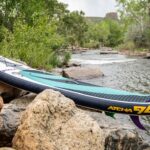Hala Gear Atcha 96 iSUP Review
Pros
- Hala’s latest design changes have made the Atcha 96 one of the best Whitewater SUPs available for big features and big thrills.
- High quality construction and materials for reliable use on whitewater year after year
- StompBox fin system allows you to use a larger fin that retracts into the board on impact
- One of the best whitewater SUPs available for harder whitewater, while still being beginner friendly
- 5-year warranty and excellent customer service
Cons
- Does not come with a paddle, however Hala’s paddles are great for use on the river
- More aggressive shaping is great for big river features, but isn’t ideal for those long stretches of flatwater between rapids
Hala’s latest design changes have made the Atcha 96 one of the best Whitewater SUPs available for big features and big thrills.
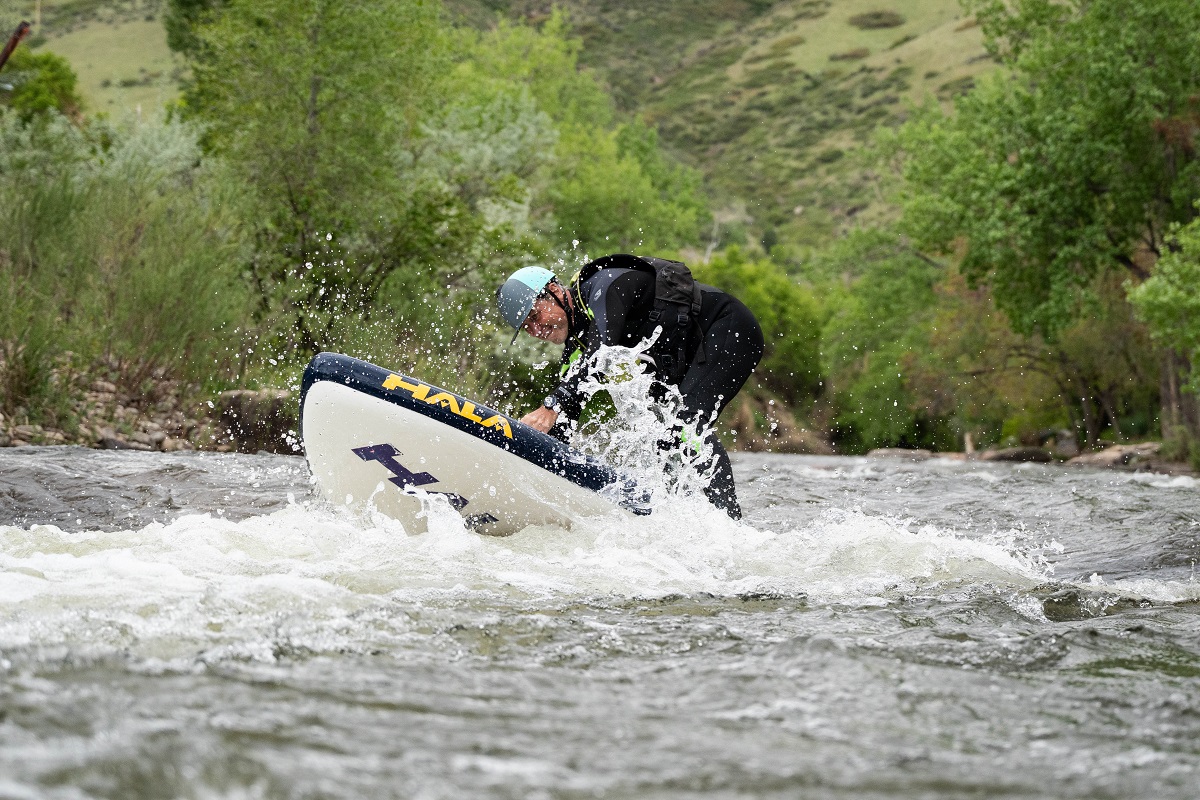
Hala Gear is one of the leading names in the whitewater SUP world, and the Atcha 96 is their flagship stand up paddle board. This is no all-around SUP, as the Atcha 96 is specifically designed for hard-charging whitewater action.
While I (Mike) have reviewed the Atcha 96 myself for InflatableBoarder.com as a whitewater paddler and river SUP instructor, I took Bill – a veteran paddler with very limited whitewater experience – and my buddy Brandon – a total whitewater novice, to the Clear Creek Whitewater Park in Golden Colorado to get their thoughts on Hala’s new paddleboards as they continued on their journeys as beginner and novice whitewater SUPers.
Not to my surprise at all, both Bill and Brandon were stoked about the Hala Atcha 96 while running wave trains, maneuvering through a rock garden, and even taking the occasional fall (if you aren’t getting wetter you aren’t getting better!) as I offered tips and took photos.
Hala’s lead designer and founder Peter Hall has been designing and building the Atcha 96 since before I was even paddleboarding. Each new version has slight tweaks and changes to the construction and shape to make it better than ever. This year’s big updates were a new woven drop stitch core and a refined rocker profile and a more tapered nose for better handling larger river features.
We think the Hala Atcha 96 would be a great SUP for:
- Intermediate and Advanced whitewater paddlers looking for ultimate whitewater performance in challenging conditions
- New whitewater paddlers who want an iSUP that can grow with them as their skills improve with the intention of paddling Class III rivers and beyond
Hala Atcha 96: Spec Sheet

- Board Categories: Whitewater / Rivers Class II+
- Listed Board Dimensions: 9’6 x 36 x 6”
- Measured Board Dimensions: 9’6” x 35.5” x 6 “
- Listed Board Weight: 27.5 lbs
- Actual Board Weight (board + finbox, inflated): 28.3 lbs
- Listed recommended Capacity: 275 lbs
- Listed max capacity: None
- Recommended PSI: 18 psi
- Fins: Retractable flexi 9” dolphin center fin, plus 2 side fins.
- Paddle: Optional
- Board Shell Construction Materials: Double layer fusion, with welded rails
- Drop-stitch type: Woven
- Price Range: High
- Warranty: 30-day refund (unused), 5-year full warranty
Performance Review of the Hala Atcha 96 Stand Up Paddle Board
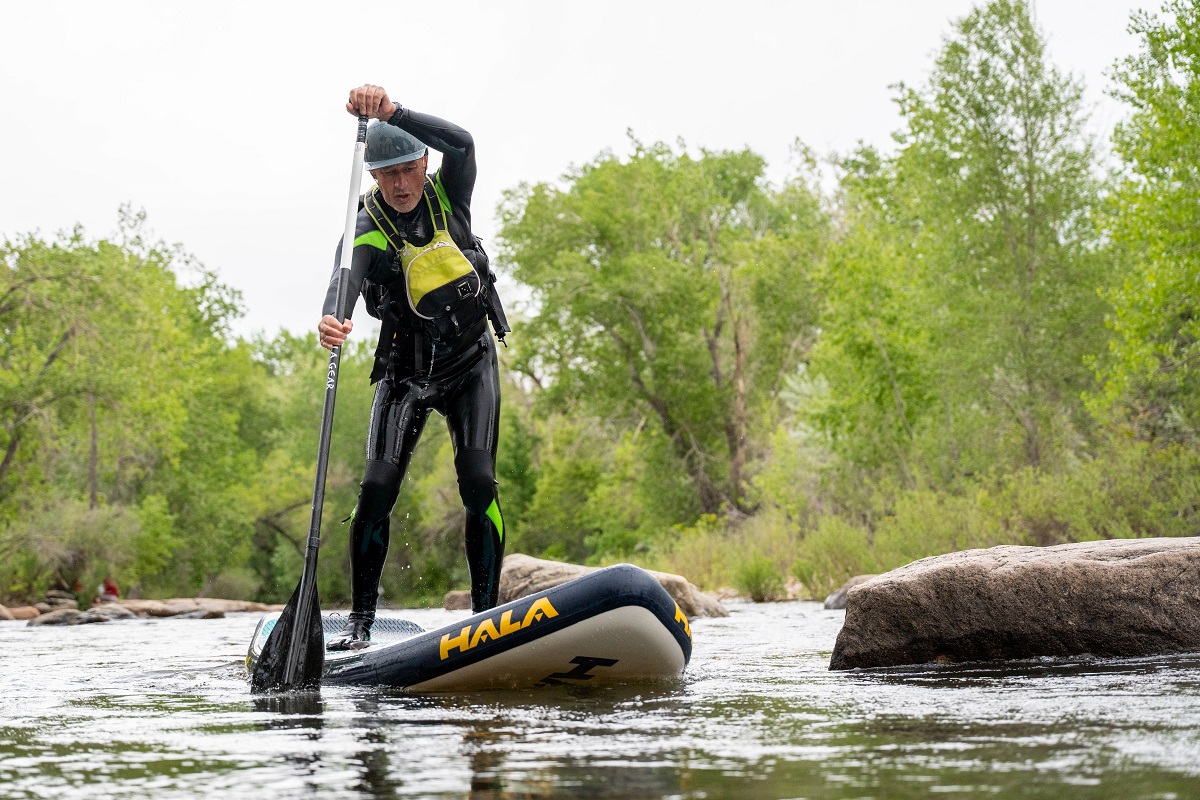
Overall Score: [9.8/10]
- Stability: 9.6/10
- Speed & Attaining: 9.0/10
- Agility: 9.8
- Waves & Drops: 9.9/10
- Construction Quality: 9.5/10
- Features/Accessories: 9.4/10
Since the Hala Atcha is a highly specialized paddleboard, we’ve adjusted our rating system to reflect its intended purpose rather than trying to squeeze it into our framework for reviewing all-around and other flatwater-designed boards.
Stability Rating: [9.6/10]
The stability score shown here is based on comparative performance to other whitewater paddleboards, rather than all paddleboards we’ve reviewed.
Stability on a fast flowing river has a different meaning than stability on flatwater. If we were to rate the Atcha 96 compared to other 35”+ SUPs you might think we’re crazy for taking this thing down rapids. But, the Atcha 96 has impressively good stability for a whitewater SUP
At 35.5” wide, it resists tipping side to side when you don’t want it to. The shortened board length and high rocker limit the amount of board that is in contact with the water at any given time. That also makes it easy to adjust the board tilt when carving turns on the river or keeping your upstream edge from pearling when you are sideways to the current.
The continuous rocker and parallel side rails keep that same level of stability as you move around on the board and adjust the trim for different maneuvers and features.
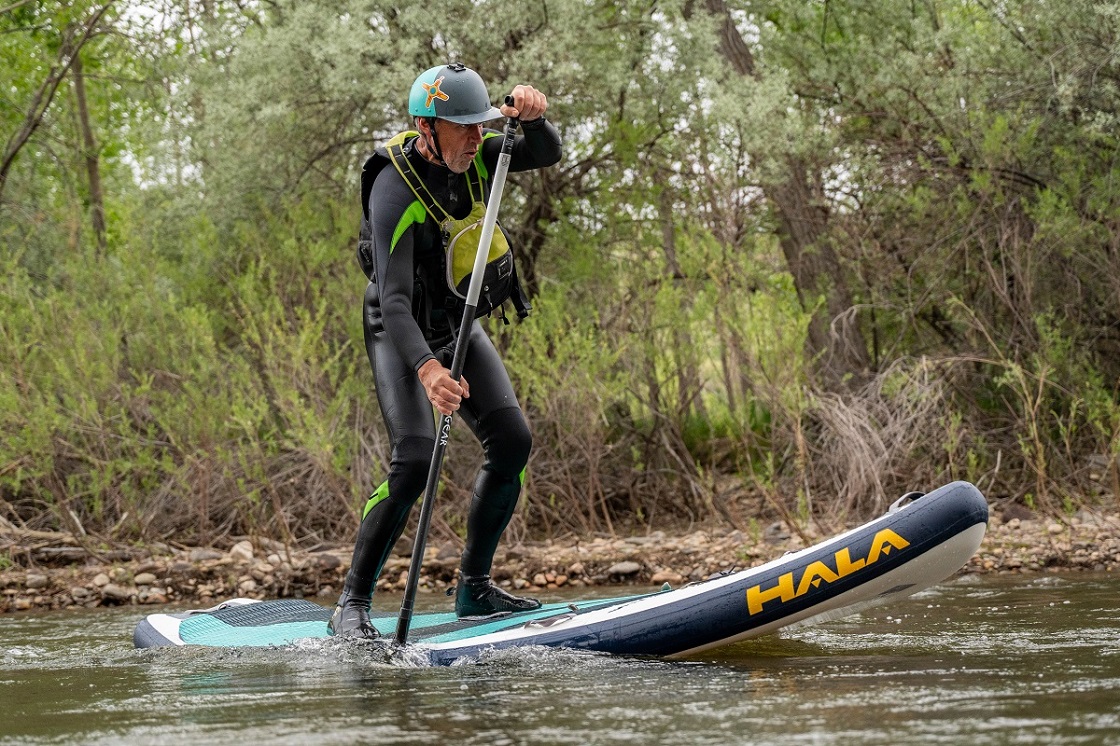
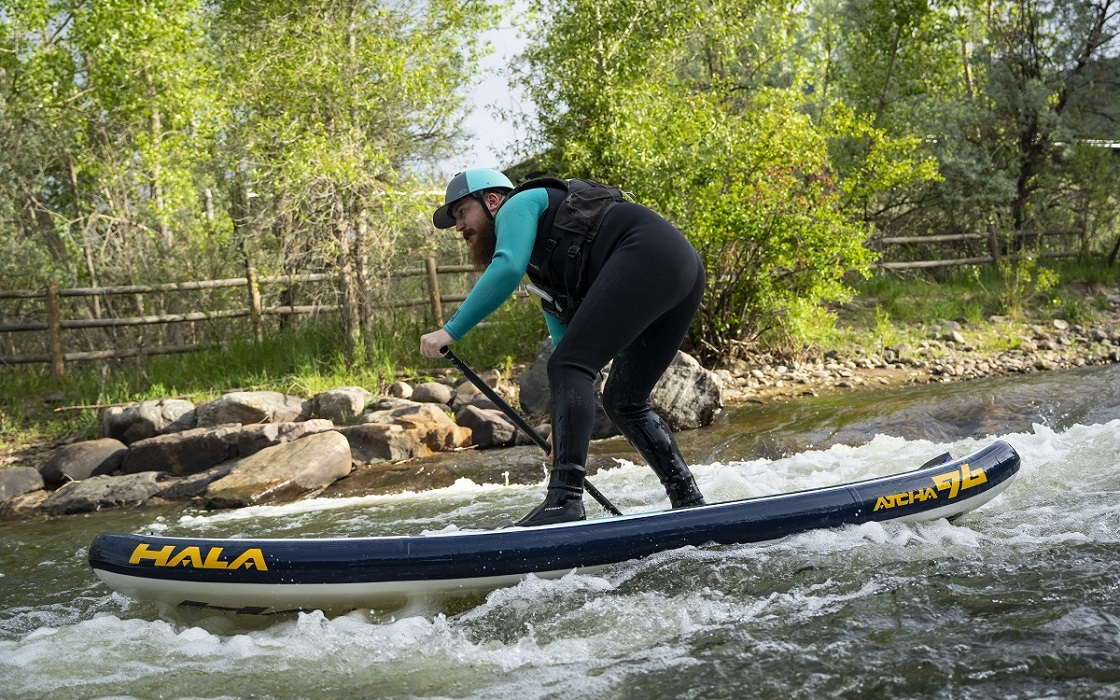
Both Brandon and Bill found the stability of the Atcha 96 to be excellent once they got a feel for it. At first they both felt the board was a little squirrely compared to their experience on flatwater SUPs, but as they began paddling over the wave trains and maneuvering through the obstacles on the river, they quickly became confident in how the board keeps them upright even though it feels different than what they are used to.
Speed & Attaining: 9.0/10
The score given above is a comparative rating to other whitewater paddleboards, but not in comparison to other types of SUPs.
Measuring the absolute speed of a whitewater SUP doesn’t really tell you anything important about the board. Very rarely are we ever sprinting downriver through waves and holes (though whitewater SUP racing is very much a thing!). But, speed control on whitewater is critical to safely navigate downriver.
Paddling speed
The Atcha 96 does accelerate quickly when you start to put some power down through the paddle. Like all whitewater boards it likes to spin easily, so properly sprinting down a straight line takes some creative paddling, but it does hold its speed well. Myself, Bill and Brandon all found the Atcha 96 to easily gain some speed when preparing to paddle through waves and holes, and it kept that speed after punching through the water. Flatter, more rounded nose shapes tend to act like a brake pedal when suddenly confronted with a large volume of water. The Atcha’s new pointed nose shape helps to pierce through the water when necessary to keep your momentum.
Attaining Up River
Paddling against the current can be a great cardio exercise, but it’s also an important skill when maneuvering on swiftwater. This lets you change your position on the river to set up for important moves, or even to help aid another paddler.
The Atcha 96 did well as we worked our way back up river and around obstacles, but did require a fair amount of effort. Once the board stabilized in its direction we were, for the most part, able to make upstream progress. Bill and Brandon both did well in calmer stretches of water, but struggled to make headway against slightly faster currents.
Overall
I found the Atcha 96 offers good speed control for whitewater paddlers and good, but not exceptional, attaining performance. Attaining is a skill that requires lots of practice to read and use micro-eddies and changes in the current to your advantage in addition to having a high-efficiency forward stroke. So I wasn’t surprised when our newer paddlers struggled in the faster water. The shorter length and high rocker make the board spin more freely than a flatter design like the Hala Radito or the Hydrus Axis.
Agility: 9.8/10
Making tight maneuvers and controlled river crossings is a critical skill for any whitewater paddler and can be greatly impacted by board and fin design.

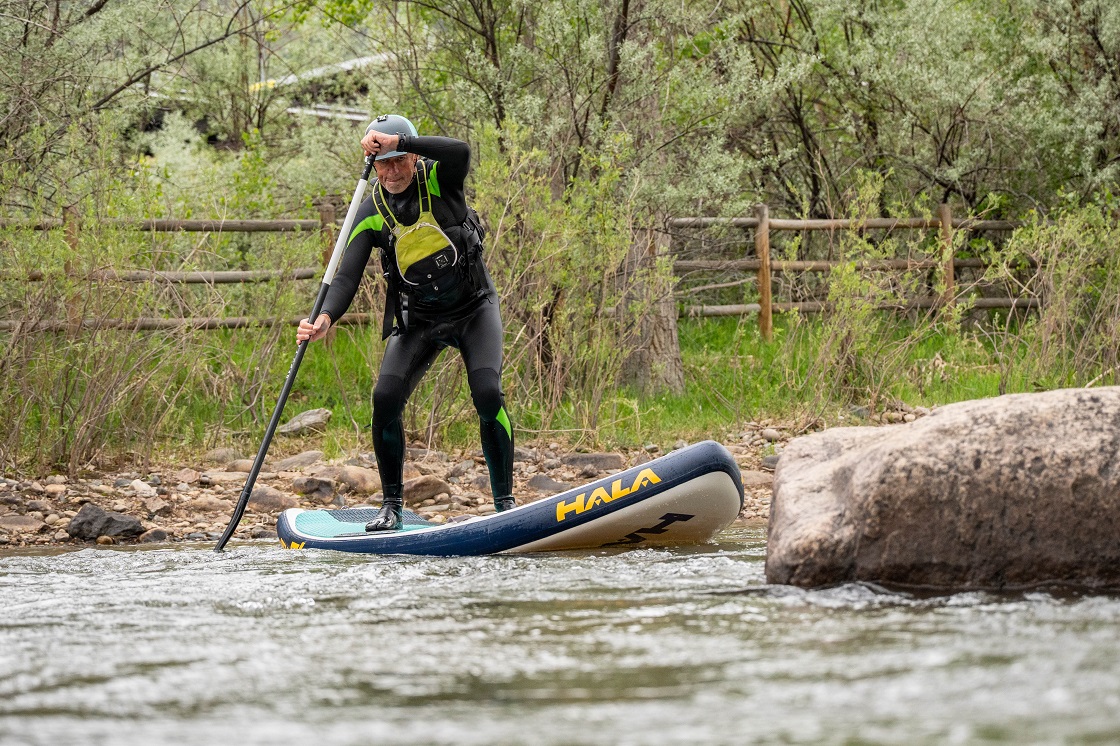
Turning
Thanks to the Atcha’s short length and high rocker profile none of our testers had a single issue turning the board. Though occasionally they did have challenges with turning it too far. The nature of whitewater SUPs is to be nimble on the water. This lets you quickly maneuver around rocks, holes, or other hazards, or quickly change position and angle to set up for your next move.
As an experienced SUP surfer (among other things), Bill quickly acclimated to the high turning sensitivity of the Atcha 96. He was able to quickly and easily change and control his angle and position with sweeps, draws, prys, and just about any other paddle stroke you can think of.
As a novice paddler, Brandon was primarily using sweeps to control his board direction. At first he consistently over-steered, but after a few minutes began to find the control in smaller sweep strokes than he was used to on a flatwater SUP. After his first 15 minutes on the water, Brandon was able to get the board pointed where he wanted to go with only occasional over steering.
Ferrying
Ferrying is the ability to move from one side of the river to the other without moving downstream. Sounds easy on paper, but it can actually be a tricky skill as you cross multiple different water speeds. By pointing your board at a specific angle (depending on the speed of the water) and adjusting the tilt of your board, you can actually use the moving water to push you across the river with very little effort on your end – if you can get those components just right.
The Atcha 96 comes with three fins. Two are small, 4.5” gummy fins for the sides of the board and one is a 9” flex fin pre-installed on the Hala StompBox retractable fin insert. You put the StompBox finbox into the Atcha before the board is pressurized, and a spring-loaded mechanism keeps this large fin in the water, but allows it to close down into the gap in the board if it strikes a rock or other object from the front (from the side or the back the flexible fin material helps minimize the impact).
Having a large fin like this makes it easier to lock in your ferry angle (and maintain your direction at any point on the river). However, I did notice that it can sometimes be too much fin when ferrying. When crossing faster currents, the fin was apt to “grab” the water and turn the board directly into the current, which stalled the ferry. It wasn’t noticeable on calmer sections of water, especially when the current was more consistent from side to side.
Once Bill understood how the tilt of the board, fin, and current interacted, he was able to effectively ferry from one side of the river to the other in mild and moderate current. Again, his prior experience SUP surfing paying large dividends here with edge control and comfort leaning the board.
Brandon struggled a bit more here as a novice paddler. There are a lot of moving parts to a successful ferry, and by the end of the day he was able to move side to side in calmer currents, but still had some issues in faster water. The combination of needing to set and adjust the board angle, tilt, and paddle were all a bit much for his first time whitewater SUPing – which is quite normal.
Overall
The Atcha 96 is very nimble on the water. I had no problems turning the board on a dime from a neutral position or staggered back over the tail. Ferrying was easy, but did require more adjustment in faster water to keep the larger fin from turning the board into the current. Hala’s StompBox uses a proprietary fin system, but they do offer a few different fin sizes and shapes. Personally, I would love to see the Atcha shipped either with a smaller fin in addition to the larger one, or have the option to select a smaller fin at checkout.
Waves & Drops: 9.9/10
You can’t have whitewater without gravity! How well a SUP handles sudden changes in elevation (both down and up) is vital for whitewater performance.
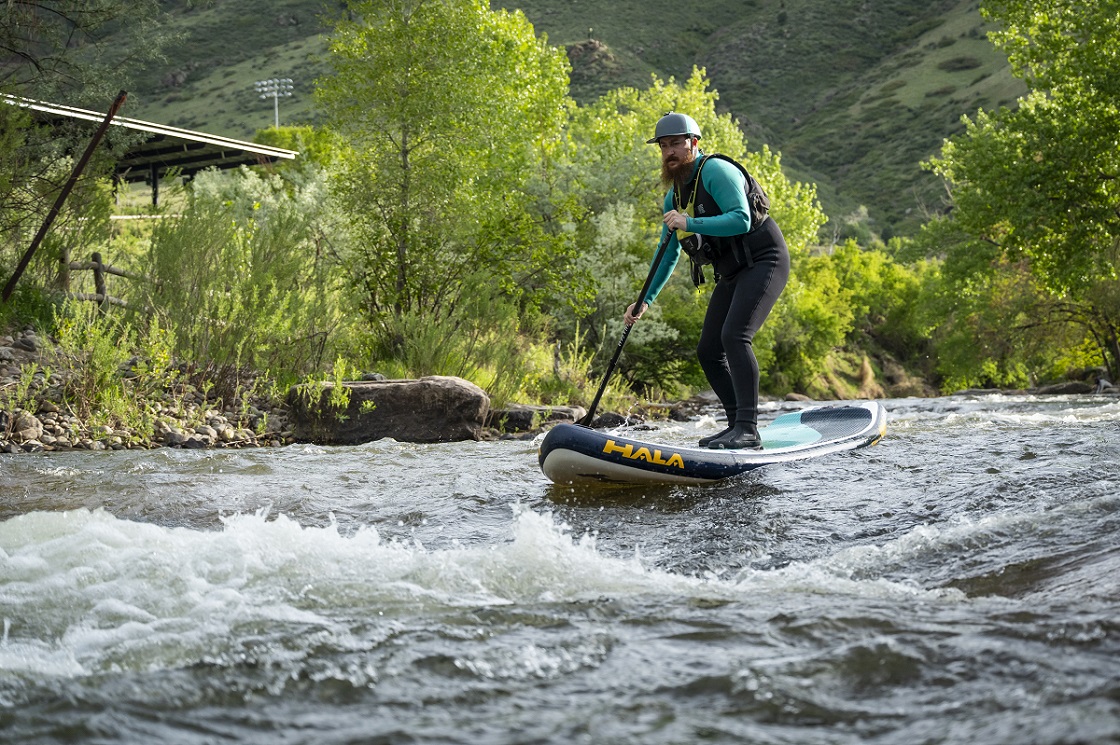
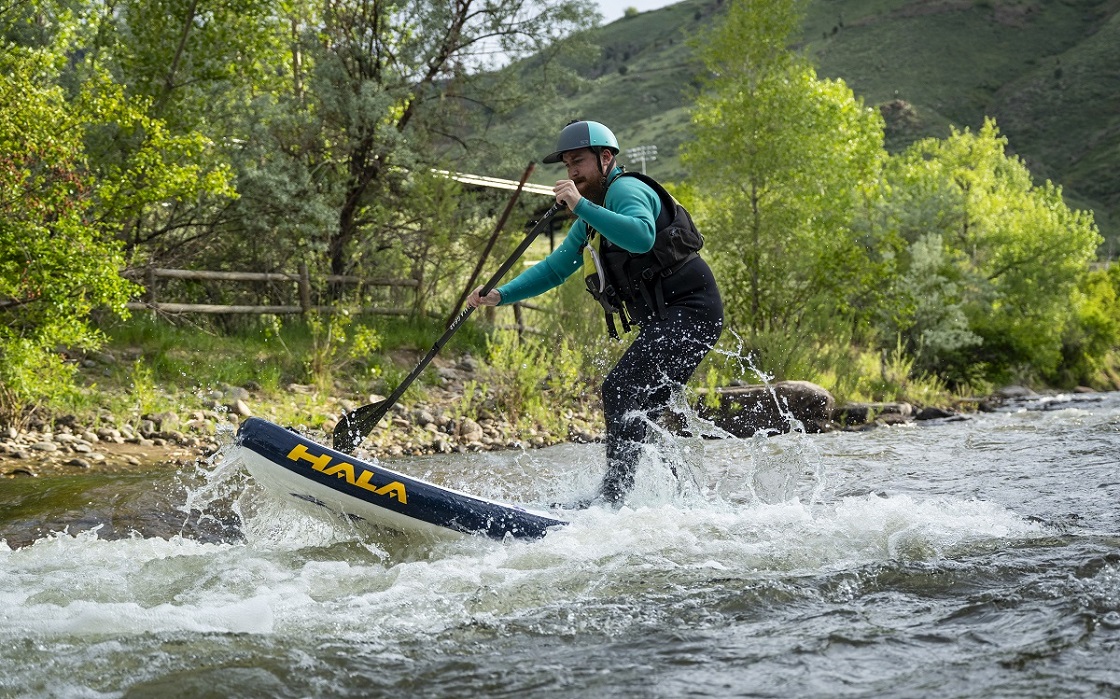
The Hala Atcha 96 is quite possibly the best SUP available for handling whitewater waves, holes, slides, and drops.
The continuous rocker profile helps the board stay trim and stable as you drop down and back up waves of any size. If the haystack is too large to fully ride over, the pointed nose cuts into the top of the wave without slamming to a stop. Dropping over a hole or pourover will tilt the board sharply down, but the nose rocker and shape help drive the board through the water and back out the top to cleanly skip out of the hole.
Slides and drops can be a big issue for whitewater SUP paddlers since we typically use fins in our boards to help pick and keep our line through the rapids. These features are notorious for bottoming out your fins and even stopping board dead in their tracks. But, Hala’s StompBox fin system lets the center fin retract fully inside the board when you paddle over these shallow-water features.
Now, if you are using the side fins you’ll still be limited to needing 6” or more water depth to avoid hitting those fins. Bill can tell you what happens when you don’t have that minimum depth for the side fins:
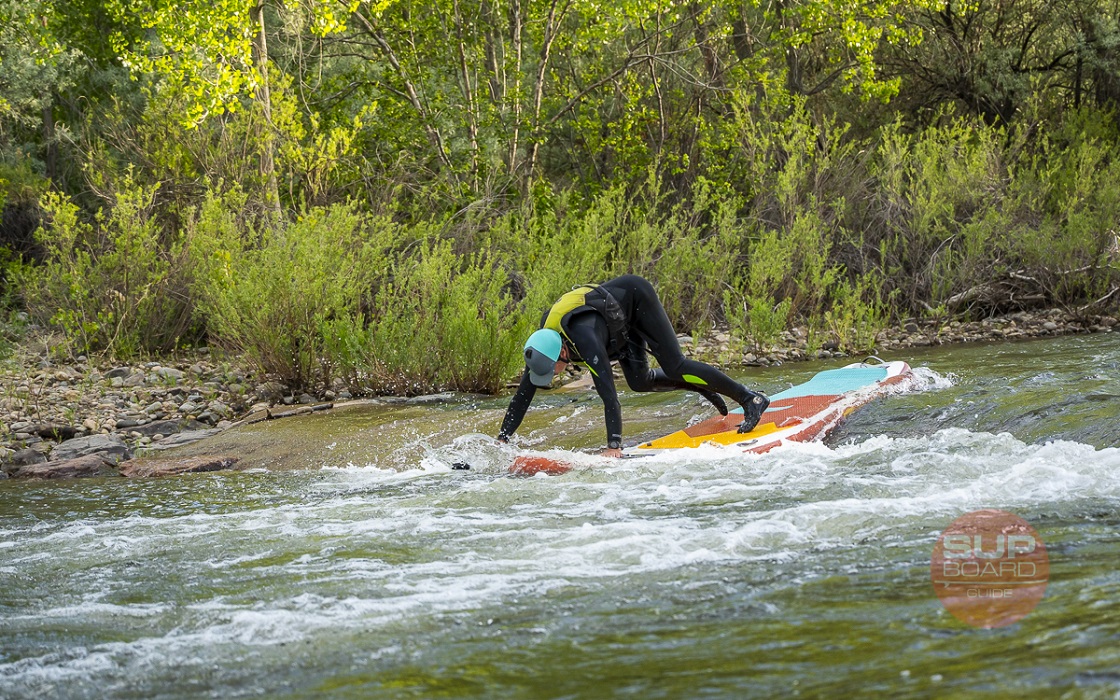
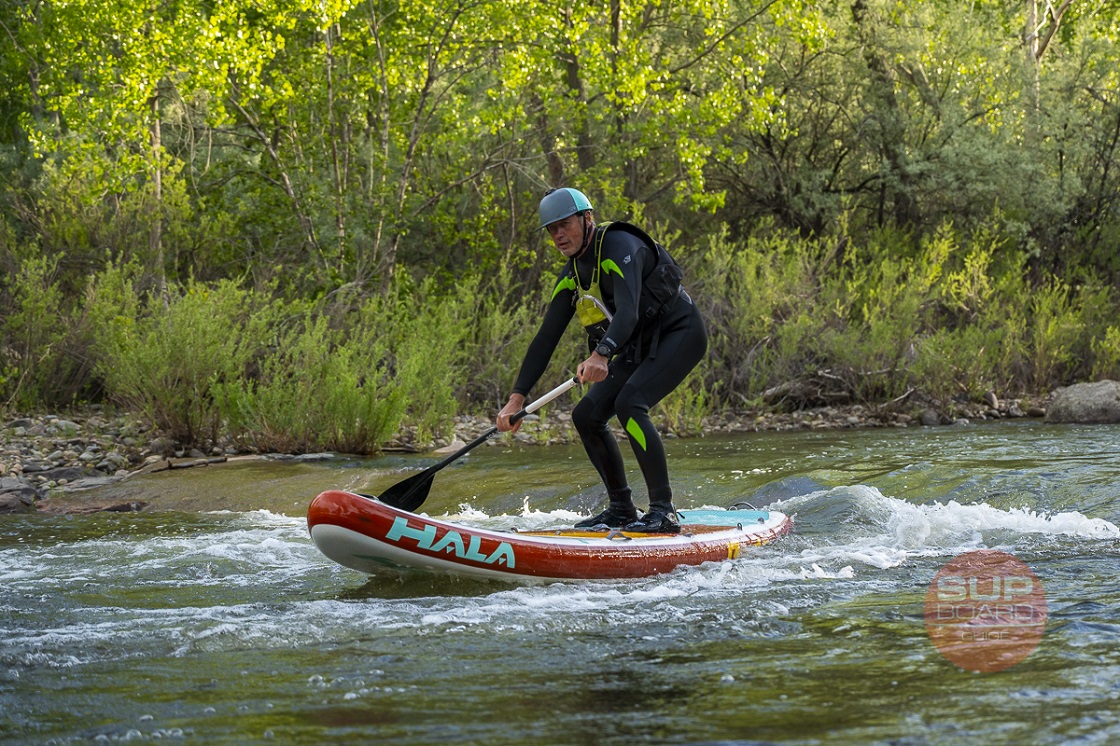
But as I like to say – If you aren’t getting wetter, you aren’t getting better. Bill got back up and cleaned it the next try (a little farther away from the large submerged rock).
If you are going to be running Class III or harder whitewater, or it’s your goal to hit those bigger waves, drops, and features, then having the refined rocker, shape, and retractable fin of the Hala Atcha 96 is about the best thing you can do to help take those lines cleanly. So why didn’t I give it a 10/10? Because I know that the team at Hala are already tinkering to make it even better – I wanted to give them room to grow. 😀
Construction Quality: 9.5/10
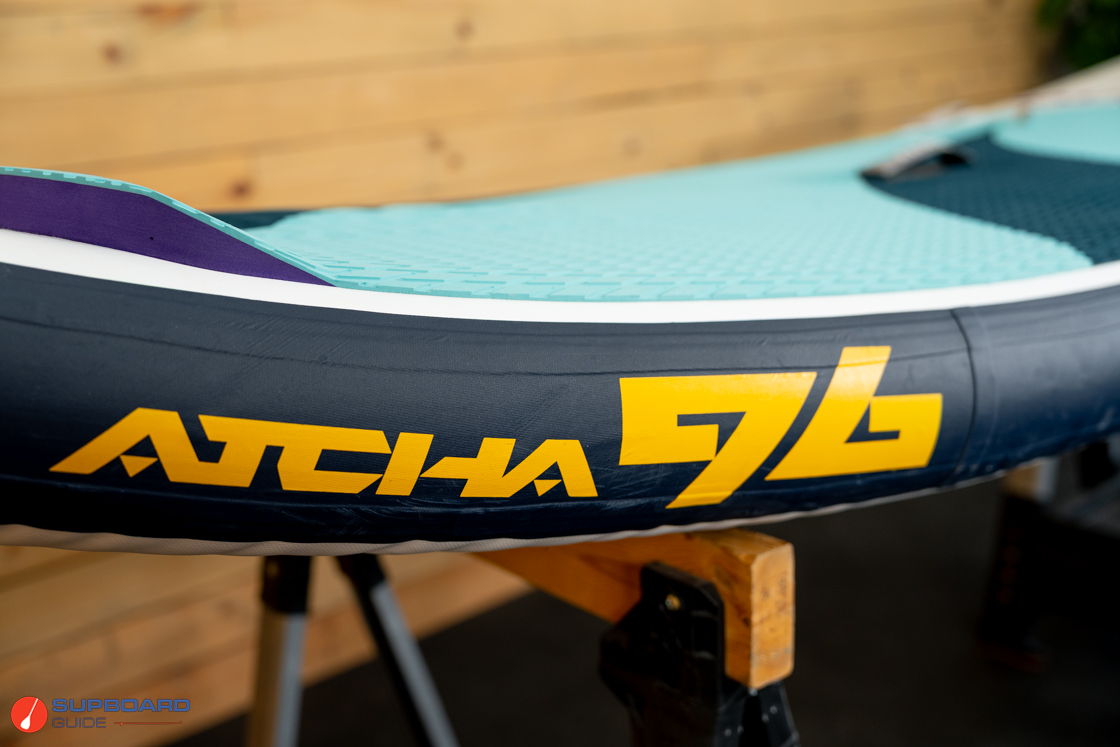
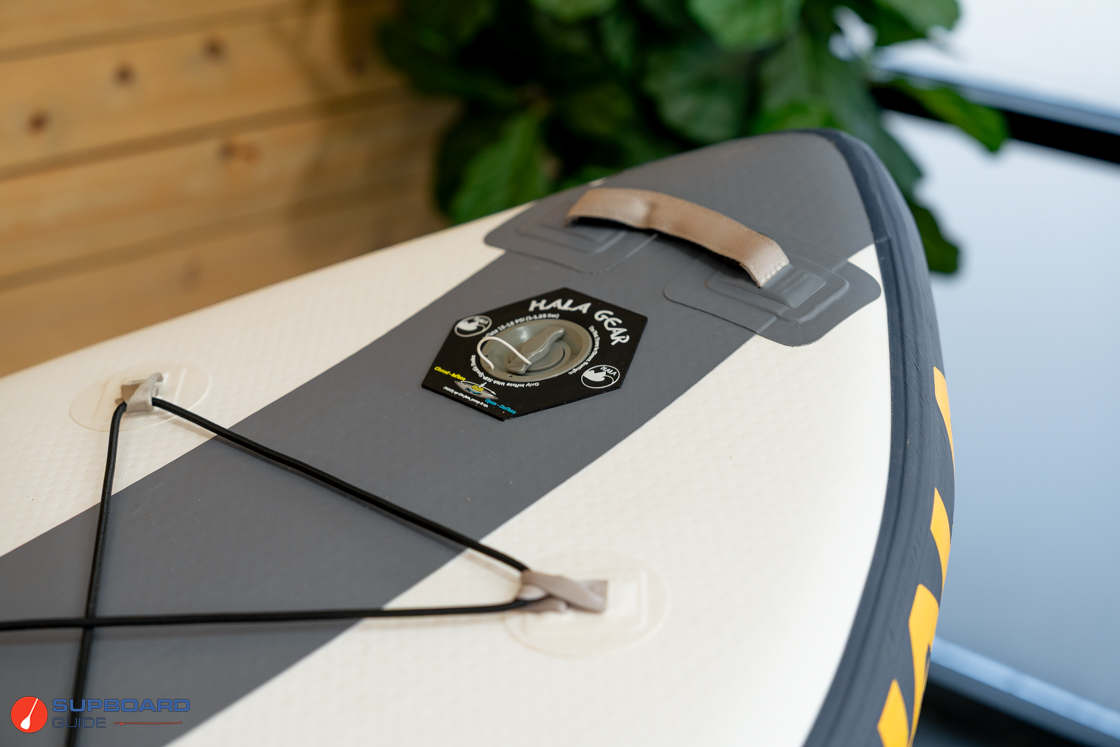
Hala has always been focused on building their boards with the highest quality materials for the job. The Atcha 96 takes into account both new materials/technology and the unique needs of a whitewater SUP.
Inside the board
The drop stitch core uses a woven fabric base layer, but rather than opting for the ultralight cross-woven stitching, Hala uses a traditional V-stitching. It’s still extremely rigid and the slightly higher weight helps maintain your momentum while paddling through whitewater.
Top and Bottom Skin
The outer skin is a dual-layer fusion PVC laminate for greater rigidity and durability to combat river rash and the other hazards of whitewater paddling. They also install a wide PVC stringer on the deck to help stiffen the board further.
Rail construction
Hala heat-welds their rails for maximum durability and longevity. This process involves both a chemical glue and a mechanical bonding process for the inner rail. The outer rail layer is more reinforced PVC that wraps around the entire board and covers the top and bottom rail connections for even more protection.
Overall
While the Atcha 96 isn’t the lightest-built iSUP out there, it is purpose-built to handle the intense rigors of whitewater paddle boarding session after session and season after season.
Board Stiffness: 1.22 ” bend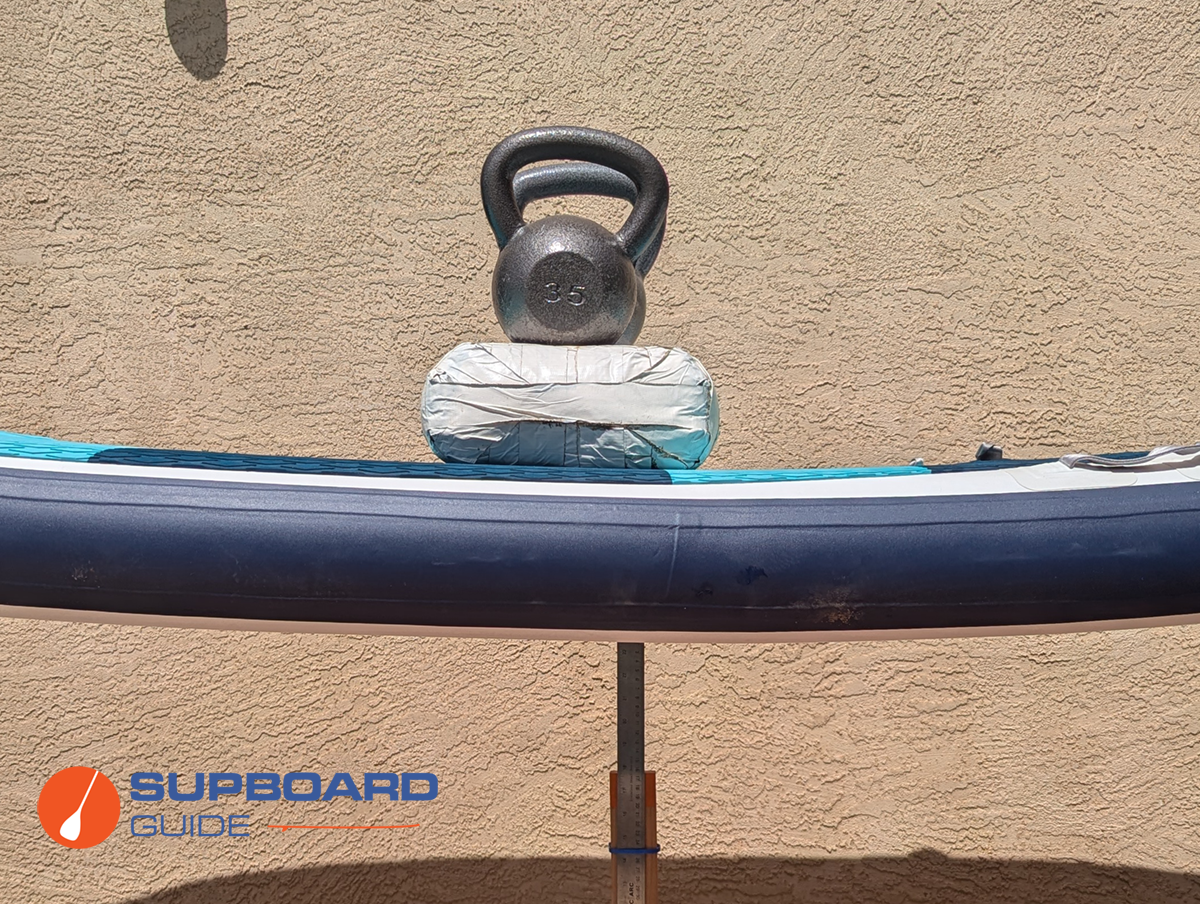
The Atcha 96 bent just over 1.2” in our deflection test with 150 pounds of weight. Don’t let the image fool you, while it looks severely bent, that’s just because the Atcha 96 has a continuous rocker profile that shapes the board with a curve from nose to tail. In reality, this is a better than average deflection test result.
On the water neither myself nor Bill or Brandon felt any flex at any time on the Atcha 96. The shorter length and wider shape of the board keep it feeling solid under your feet, even when paddling through whitewater or hitting a few rocks.
To ascertain the rigidity of each board we review, we use our own specific laboratory bend test process. The board is inflated to its maximum recommended PSI and then placed across two sawhorses positioned exactly 7 feet apart. We then measure the distance from the middle of the board to the floor. Then, we place a 150 lb weight on the middle top of the SUP, and measure the distance to the floor again. The difference between the two measurements shows the deflection, or ‘sag’, that the board has experienced due to the added weight. We have been reviewing the stiffness of boards using this technique since 2021 and while it isn’t an exact replication of the weight distortion that occurs when a rider stands on a SUP board in the water, it still gives a very useful comparative tool in determining the stiffness of the board’s construction process.
Features/Accessory Review: [9.5/10]
Features:

Let’s start with the deck pad. The two-toned pad is covered in a high-traction diamond texture for sure footing even when the board is hanging halfway over a pourover. There’s an indexing pad in the center of the board near the tail to help keep your feet in the right location over the centerline of the board. Though I did struggle to feel this at times while wearing thicker-soled whitewater shoes like the Astral Rassler. At the tail of the deck pad is a large raised kick pad to prevent you from stepping off the back of the board and give you more control and stability when standing all the way back on the tail.
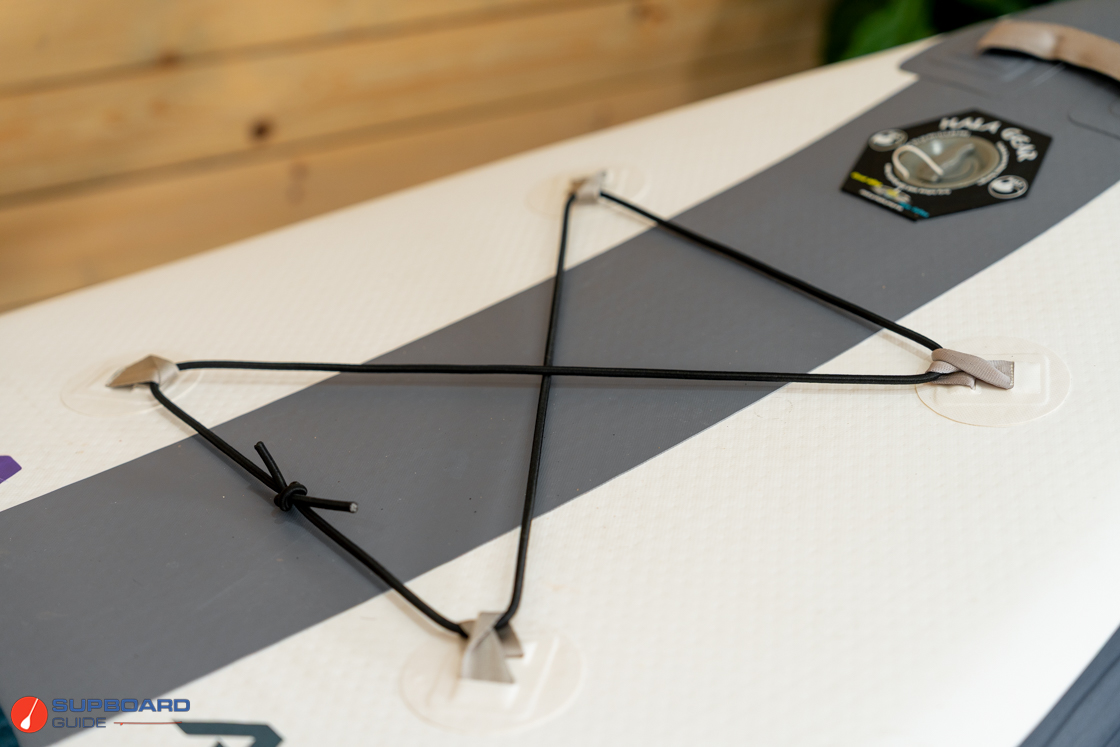
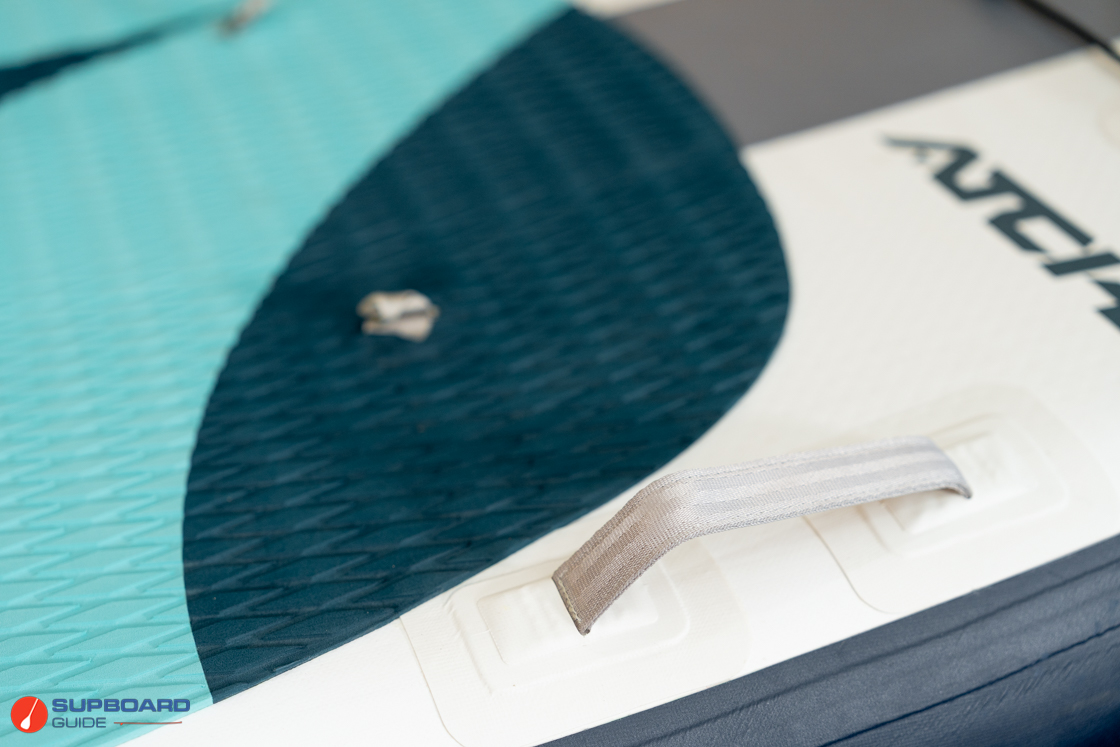
The deck is kept mostly clear to give you plenty of room to move around and remove any tripping hazards. There is a front cargo area with a tied bungee cord threaded through four soft tie down points. These nylon loops give a small safety margin against bruises and caught fingers compared to steel D-rings. Hala also includes two more soft rigging points at the top of the deck pad (though no bungee cord). You can use these to either extend the front cargo area or with a small cord to tie down a water bottle or other quick-access item.
There are two grab handles at the front of the deck pad. If you are taking a little one down their first whitewater run, this is a great place for them to kneel and hold on. But if you are hitting the big stuff, these are just as helpful for you to hold on after taking a knee or falling off your board. There are also three carrying handles on the Atcha 96 (nose, center and tail) all of which lay mostly flat to the board to help stay out of the way while paddling.
The tail of the board has a raised kick pad and a central indexing pad to help you set your foot position without needing to look down and improve stability and control when lifting the nose farther out of the water.
The tail has a reinforced leash attachment point as well. While leashes are basically taken as a fact of flatwater SUP safety, they can become deadly on moving water. Only ever use a quick release leash on moving water, and only after you have trained extensively with it. They are not a “silver bullet” to paddling safety. You’ll notice that Bill and Brandon are not wearing leashes in these photos. As they have not trained heavily with a quick release leash, the safest way to paddle was without a leash at all. We did have to chase a board a few times, but that is far preferable to leash entanglement.
The tail of the Atcha 96 (and Hala’s other whitewater specific SUPs) has a fish-tail shape. The idea of this shape is that it gives you most of the stability of a square tail from the total outside width, but the cutout helps improve maneuverability and control when surfing on those mushier whitewater waves.
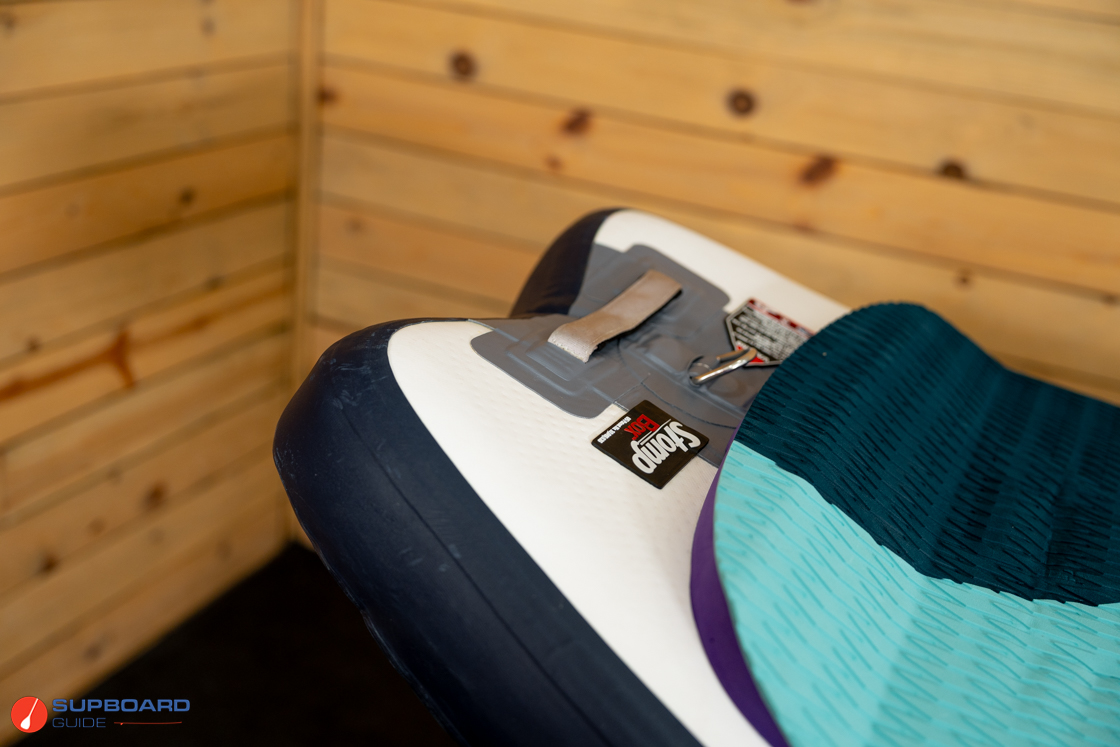
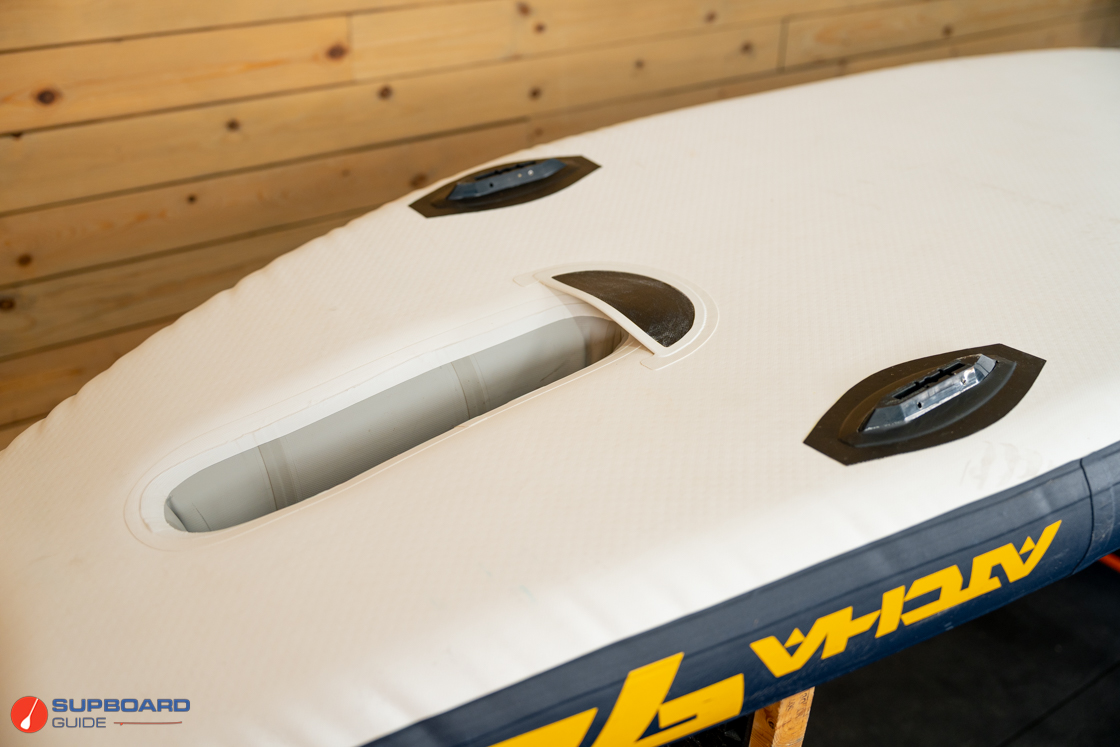
Under the Atcha 96 there are two traditional fin boxes and a hollow to fit the patented StompBox fin system. The two side fins use FCS style fin boxes and are compatible with the included 4.5” surf fins, as well as hundreds of other fin options available. They are slightly toed-in as well to help boost performance while surfing on steeper river waves.
The StompBox fin system inserts into the bottom of the board during inflation, but before the board is pressurized. Small foam blocks, pressure from the board, and a reinforced leading edge all keep the StompBox securely in place while on the water. By recessing the fin box like this, the spring-loaded mechanism allows the 9” fin to fully retract into the board when it hits an object from the front. The flexible fin material helps lessen impacts from the side or rear.
Two things that I think are missing from the Hala Atcha 96 that would be improvements for paddlers are a GoPro-compatible / threaded mounting point on the nose of the board and a towing D-ring at the front of the board.
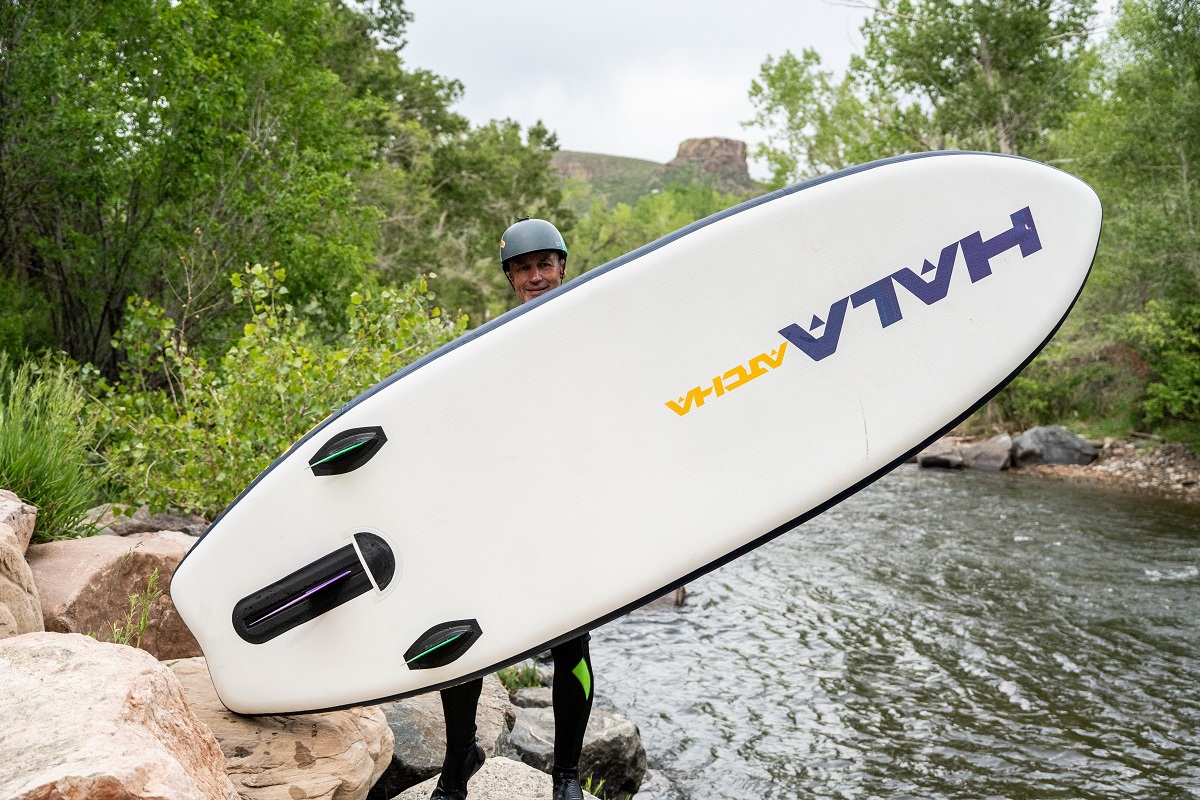
Included Accessories:
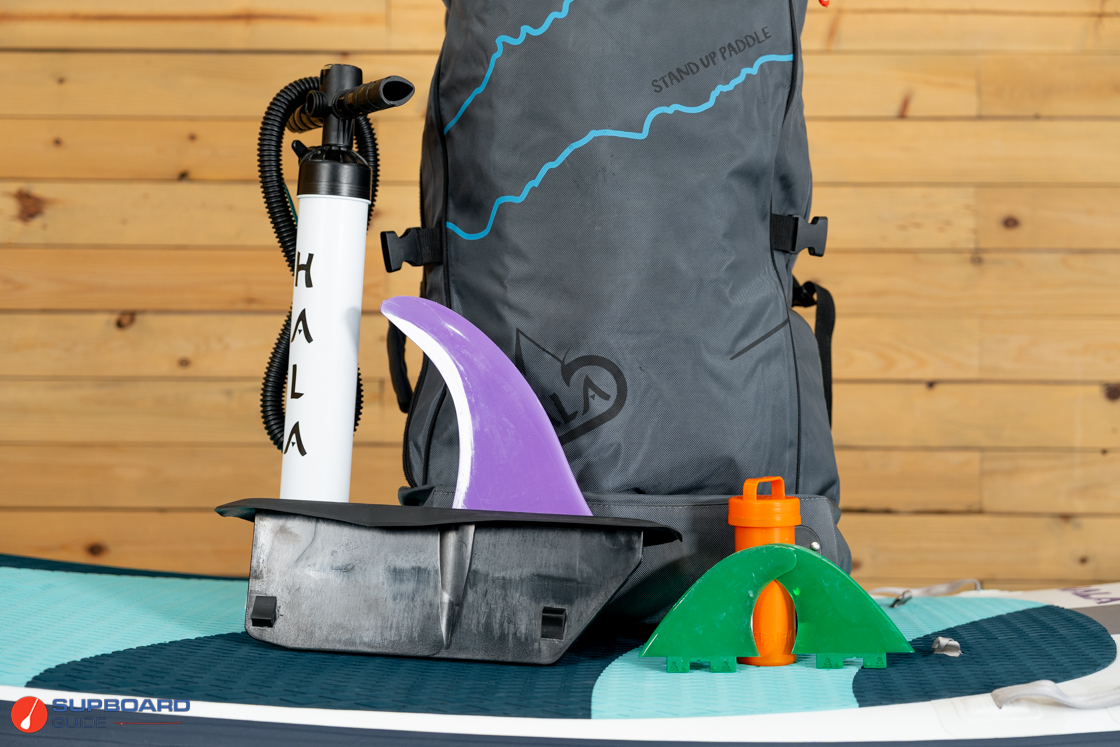
The Hala Atcha 96 comes with a basic set of high-quality accessories. Along with the board you get a nice duffel-opening roller backpack sized to fit the Atcha 96, a double-action hand pump, basic repair kit, two 4.5” flex fins with a fin key, and the StompBox fin box with a 9” fin pre-installed.
Hala does not include a paddle with the Atcha 96, nor do they offer their paddle at a discount when bundled with the board. While this would be a negative for a typical flatwater board, I don’t see this as a problem with a whitewater SUP. Most paddlers purchasing a whitewater SUP will already have a paddle they like. If not, Hala’s Grafik paddles are made for the river with a large 7-layer composite blade and carbon fiber shaft for durability and rigidity.
Summary Review of the Hala Atcha 96
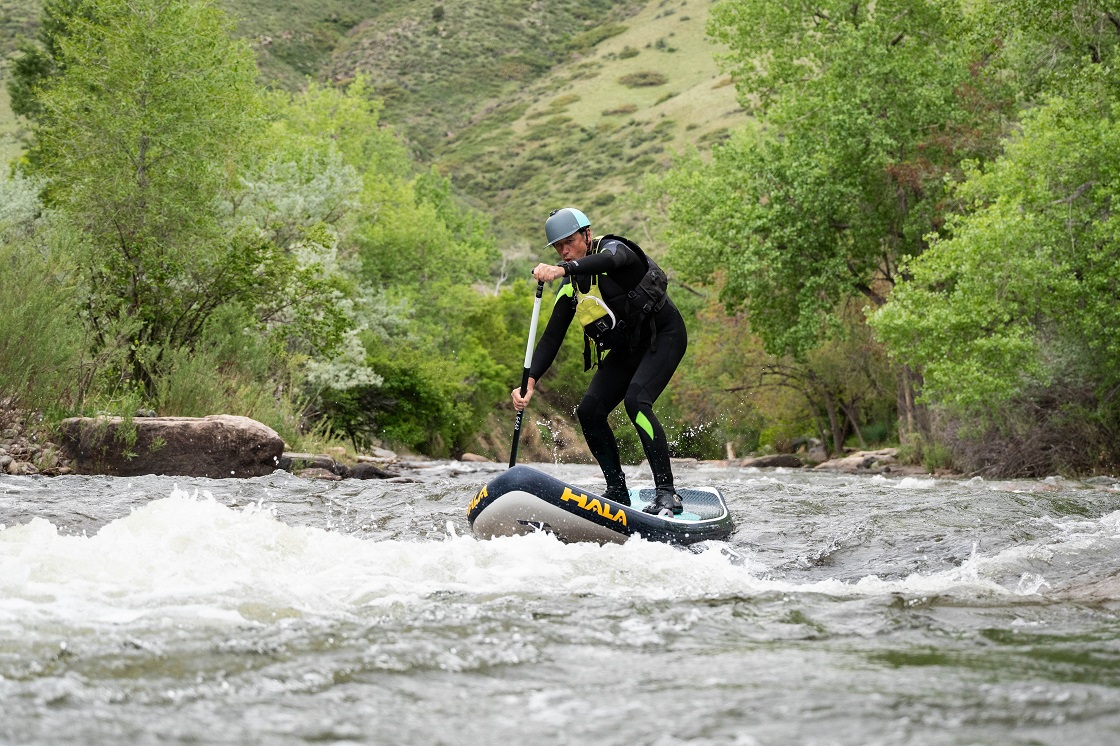
The Hala Atcha 96 is probably the best known SUP on the river, at least in the US (though they are definitely starting to make a splash in the UK and EU). It’s been refined year after year for ever higher levels of performance and adventure.
If you are a whitewater paddler or are wanting to get into whitewater paddling, the Hala Atcha 96 should be very high on your list of SUPs. If you plan on regularly paddling Class III or harder, or that is your goal in the next couple of seasons, it should be at the top of your list. However, if you are just getting started in whitewater or enjoy the fun of Class II-III rivers without wanting to venture into the spicier realms of Class III+ then you might prefer the slightly toned-down, but very capable, shape of the Hala Radito for more primary stability and better paddling on those flat sections between rapids.
But, at the end of our paddling session in Golden, both Brandon and Bill pointed to the Hala Atcha 96 as their favorite of the day! For playing in the whitewater park they preferred its higher maneuverability and sportier feel.
If you have any questions or comments please let us know below!
SupBoardGuide
Latest posts by SupBoardGuide (see all)
- Best Kids Paddle Boards (SUPs) – 2025 - November 11, 2025
- Best Stand Up Paddle Board for Fishing – 2025 - November 11, 2025
- Best Yoga SUPs of 2025 - November 11, 2025


